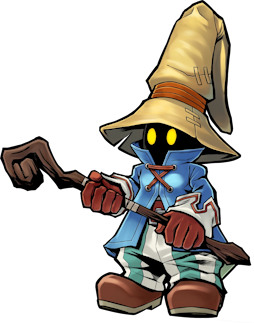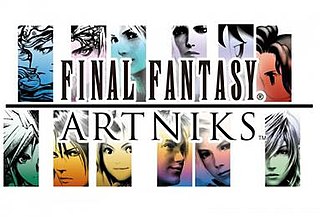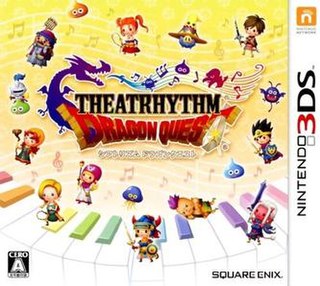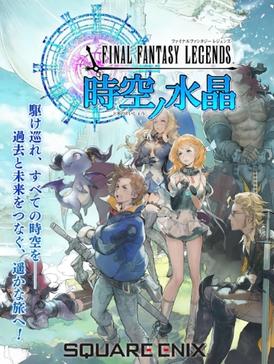Final Fantasy is a fantasy anthology media franchise created by Hironobu Sakaguchi which is owned and developed and published by Square Enix. The franchise centers on a series of fantasy role-playing video games. The first game in the series was released in 1987, with 16 numbered main entries having been released to date.

Final Fantasy IV, known as Final Fantasy II for its initial North American release, is a role-playing video game developed and published by Square for the Super Nintendo Entertainment System. Released in 1991, it is the fourth main installment of the Final Fantasy series. The game's story follows Cecil, a dark knight, as he tries to prevent the sorcerer Golbez from seizing powerful crystals and destroying the world. He is joined on this quest by a frequently changing group of allies. Final Fantasy IV introduced innovations that became staples of the Final Fantasy series and role-playing games in general. Its "Active Time Battle" system was used in five subsequent Final Fantasy games, and unlike prior games in the series, IV gave each character their own unchangeable character class.

Final Fantasy Adventure, known in Japan as Seiken Densetsu: Final Fantasy Gaiden or simply Seiken Densetsu, and later released in Europe as Mystic Quest, is an action role-playing video game developed and published by Square for the Game Boy. It is a spin-off of the Final Fantasy series and the first game in the Mana series. It was re-released by Sunsoft in April 1998.

Final Fantasy V is a fantasy role-playing video game developed and published by Square in 1992. It is the fifth main installment of the Final Fantasy series. The game first appeared only in Japan on Nintendo's Super Famicom. It has been ported with minor differences to Sony's PlayStation and Nintendo's Game Boy Advance. An original video animation produced in 1994 called Final Fantasy: Legend of the Crystals serves as a sequel to the events depicted in the game. It was released for the PlayStation Network on April 6, 2011, in Japan. An enhanced port of the game, with new high-resolution graphics and a touch-based interface, was released for iPhone and iPad on March 28, 2013, for Android on September 25 the same year and for Windows on September 24, 2015. A more enhanced re-release of the game as part of the Final Fantasy Pixel Remaster series, was released on November 10, 2021 for Android, iOS, and Windows, and for Nintendo Switch and PlayStation 4 on April 19, 2023.

Final Fantasy III is a role-playing video game developed and published by Square for the Family Computer. The third installment in the Final Fantasy series, it is the first numbered Final Fantasy game to feature the job-change system. The story revolves around four orphaned youths drawn to a crystal of light. The crystal grants them some of its power, and instructs them to go forth and restore balance to the world. Not knowing what to make of the crystal's pronouncements, but nonetheless recognizing the importance of its words, the four inform their adoptive families of their mission and set out to explore and bring back balance to the world.
Ryuji Sasai is a Japanese video game composer and bass guitarist. He is best known for his work on Xak, Final Fantasy Legend III and Final Fantasy Mystic Quest. His musical career came about when he was 15 years old, and he formed a band. Before entering the gaming industry, Sasai was involved in the anime department, scoring two television series and a film. After creating music for four games as a freelancer, he was employed at Square from 1991 to 1998, where he worked on five games in total. Sasai often collaborated with fellow composers Tadahiro Nitta and Chihiro Fujioka during his career. He has also been a member of the rock bands Novela and Action and is currently performing as a bassist.

Faris Scherwiz is a character in the Final Fantasy series. She first appears in Final Fantasy V as an early antagonist and later one of its protagonists. She was born Princess Sarisa Scherwil Tycoon, but was lost at sea and raised as a boy by pirates. She joins the group, hoping to understand why protagonist Lenna Charlotte Tycoon has the same pendant as her. She was created by Hironobu Sakaguchi and was based on the protagonist of the manga Princess Knight. Her promotional artwork was created by Yoshitaka Amano.

Final Fantasy Tactics A2: Grimoire of the Rift is a tactical role-playing game developed and published by Square Enix for the Nintendo DS handheld game console. Releasing in 2007 in Japan and 2008 in the West, the game is a sequel to Final Fantasy Tactics Advance and forms part of the Ivalice Alliance, a group of games set in the titular fictional universe. The game features cameo appearances from central and supporting characters from Final Fantasy XII, a title set in Ivalice.

Vivi Ornitier is a video game character in the Final Fantasy series. He appears in the video game Final Fantasy IX, where he serves as one of the game's main protagonists. He is a shy character who through the game's plot grapples with the trauma of discovering his past and identity. He is a Black Mage, a class of magic users who employ fire, ice, lightning, and other elements into their magic. His design took inspiration from the film The Dark Crystal and was meant to appear both realistic and comic-like; part of the game's world was designed around him in turn. He has appeared in other games such as the Theatrhythm Final Fantasy series, Kingdom Hearts II, and World of Final Fantasy. A felt doll of Vivi was included with pre-orders of the Japanese original release of FFIX.

Dissidia Final Fantasy is a fighting game with action RPG elements developed and published by Square Enix for the PlayStation Portable as part of the campaign for the Final Fantasy series' 20th anniversary. It was released in Japan on December 18, 2008, in North America on August 25, 2009, and in Australia and Europe in September. It was then re-released in Japan, based on the North American version, as Dissidia Final Fantasy: Universal Tuning, on November 1, 2009.

Theatrhythm Final Fantasy is a rhythm video game, developed by indieszero and published by Square Enix for Nintendo 3DS and iOS. Based on the Final Fantasy video game franchise, the game involves using the touch screen in time to various pieces of music from the series. The game was released in Japan in February 2012, and in North America, Australia and Europe in July. An iOS version was released in December. A sequel, Theatrhythm Final Fantasy: Curtain Call, was released in 2014. A third game based on the Dragon Quest series, Theatrhythm Dragon Quest, was released in 2015. An arcade game, Theatrhythm Final Fantasy: All-Star Carnival, was released in 2016. A second sequel, Theatrhythm Final Bar Line, was released on February 16, 2023 for Nintendo Switch and PlayStation 4.

Bravely Default, known in Japan as Bravely Default: Flying Fairy, is a role-playing video game developed by Silicon Studio for the Nintendo 3DS handheld console. Bravely Default was originally released in 2012 and later rereleased as an expanded edition in 2013 subtitled For the Sequel in Japan. For the Sequel was later released in Europe, Australia, and North America in 2014 simply titled as Bravely Default. This expanded edition used the subtitle Where The Fairy Flies in territories outside of Japan. Square Enix published the game in Japan, while Nintendo handled publishing duties overseas. The gameplay uses a turn-based battle system and job system, in addition to incorporating options to combine job abilities and adjust battle speed and random encounter rates.

Final Fantasy Airborne Brigade, known in Japan as Final Fantasy Brigade was a Final Fantasy video game developed and published by Square Enix for Mobage compatible mobile phones. The game was similar to other traditional Final Fantasy games with an overworld and dungeons, but was socially oriented. There were over 2.5 million players just in Japan, though reviews have commented on the game's lack of polish and sound.

Lightning Returns: Final Fantasy XIII is an action role-playing game developed and published by Square Enix. It is a sequel to Final Fantasy XIII-2, concludes the storyline of Final Fantasy XIII, and forms part of the Fabula Nova Crystallis subseries. It was released in 2013 in Japan and 2014 in North America and PAL regions, and was ported to Windows in 2015 and Android and iOS through cloud gaming in 2016 in Japan. Lightning Returns employs a highly revamped version of the gameplay system from the previous two games, with an action-oriented battle system, the ability to customize the player character's outfits, and a time limit the player must extend by completing story missions and side quests.

Final Fantasy is a fantasy role-playing video game developed and published by Square in 1987. It is the first game in Square's Final Fantasy series, created by Hironobu Sakaguchi. Originally released for the NES, Final Fantasy was remade for several video game consoles and is frequently packaged with Final Fantasy II in video game collections. The first Final Fantasy story follows four youths called the Warriors of Light, who each carry one of their world's four elemental crystals which have been darkened by the four Elemental Fiends. Together, they quest to defeat these evil forces, restore light to the crystals, and save their world.

Final Fantasy Artniks was a Japanese video game developed by Square Enix and the GREE social network. It is the second Final Fantasy social game and the second game developed with GREE.

Final Fantasy Explorers is an action role-playing video game for the Nintendo 3DS. It features character job-oriented combat against classic Final Fantasy monsters and summons. It was released in Japan in December 2014, and in North America and Europe in January 2016.

Theatrhythm Final Fantasy: Curtain Call is a rhythm video game. A sequel to the 2012 video game Theatrhythm Final Fantasy and the second title in the rhythm series, it features similar gameplay to its predecessor. It was released for the Nintendo 3DS on April 24, 2014 in Japan, and in September for other markets.

Theatrhythm Dragon Quest is a rhythm game developed by indieszero and published by Square Enix for the Nintendo 3DS. It was released in Japan on March 26, 2015, and was the first game of its type in the Dragon Quest series and the third Theatrhythm game after Theatrhythm Final Fantasy and Theatrhythm Final Fantasy: Curtain Call.

Final Fantasy Dimensions II, also known as Final Fantasy Legends II: Jikuu no Suishō in Japan, is a free-to-play game developed by Matrix Software and published by Square Enix for Android and iOS devices. It is the second game released in Japan with the "Final Fantasy Legends" title after Final Fantasy Legends: Hikari to Yami no Senshi. It revolves around traveling through time in order to save the world from a god.




















